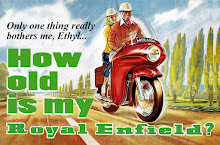A Royal Enfield based Indian Patrol Car is back on the market.
"Yes, after looking at all of the missing pieces I decided it was too big of a project for me, given that I don't have a machine shop readily accessible," Bill Erickson told me.
The 1959 three-wheeler, built by Pashley in England, powered by a Royal Enfield Bullet motor, and sold in the United States as an Indian, is now in Oswego, Ill. Asking price is $4,500.
The sale prompted Richard McLeish of the UK to offer some information about the history of Indian Patrol Cars. He owns one. His Patrol Car was imported into the United States and made the return trip to the home country.
"I doubt if they were ever expected to get above about 30 mph, just pootle around in town," McLeish writes. "Did you know that these had a three-speed-and-reverse gearbox, with hand change and foot throttle? Makes for interesting driving."
Reverse? But how do you get reverse out of what looks like an ordinary Albion gearbox, I asked.
"The reverse gear is indeed fitted into the basic Bullet four speed gearbox design," he replied. "The gear case was modified, with a bulge on the back wall creating the extra space necessary to incorporate the extra shaft and cog required, and the 'box then effectively had reverse where first used to be; then N-1-2-3.
 "I presume that hand change was required to help prevent changing from forward into reverse whilst in motion. This was done by using a gate arrangement bolted to the right-hand side of the tank. The change linkage actually goes via the gear indicator mechanism, nothing is connected to where the foot-change pedal is located on a conventional two-wheeler...."
"I presume that hand change was required to help prevent changing from forward into reverse whilst in motion. This was done by using a gate arrangement bolted to the right-hand side of the tank. The change linkage actually goes via the gear indicator mechanism, nothing is connected to where the foot-change pedal is located on a conventional two-wheeler...."Does his Patrol Car have a differential? Unclear, McLeish advises.
"The parts book I have shows two different designs of rear axle for Pashleys, and the illustrations for the type on my machine omit the final drive arrangement completely... It certainly drives as if the axle is rigid, I can vouch for that. The steering damper is very necessary!"
McLeish thinks a reference I found on the Internet to a shaft-drive Royal Enfield Pashley is mistaken. There is no mention of shaft drive in the parts book, he writes. (Update: But see Jorge Pullin's My Royal Enfields blog, which has a clipping explaining the shaft-drive system!)
Other elements varied. "The Indian models generally seem to have had the wide forks also used on the Enfield Indian Chief, along with the associated spoked 16-inch front wheel — certainly brochures and advertisements show them thus. Mine, however, has the narrower standard motorcycle forks and 19-inch wheel used on some other Pashleys.... It came from the U.S. like that, and was titled in the U.S. as a 1958, whereas Indian listed them only for 1959. Lucas parts on it are marked 1958, so I can only assume it was a very early version....
"Exactly how many were made is not known, but certainly more than most people seem to think. Fifty-two were reported as going to the Toronto Police; whether these were Pashleys or Indians, I don't know....
"As to survivors... I personally know of 10 extant, though not necessarily complete, and have recorded reports of several more, though I do not know how many of these latter are Indian Patrol Cars, as opposed to Pashley Enfields.
"The Pashley company is still trading, and are renowned in the cycling world. The current management bought the business out from the Pashley family years ago; regrettably, they are unable to help with any information on these old clunkers."
What are the old clunkers worth? McLeish points out that there is a nice, running, 1959 Patrol Car for sale in St. Paul, Minn. Asking price is $20,000. The pictures provided in that ad illustrate the shifting mechanism nicely, and also the unadorned tail of the Indian Patrol Car.






































I have one of these ,almost complete , runs great I would like to talk to anybody out there who has one or parts via email jimstreetbob@yahoo.com
ReplyDeleteI have one completely restored its beautiful
ReplyDeletehello, would you please contact me under gbbmh@gmx.ch , thanx
Delete